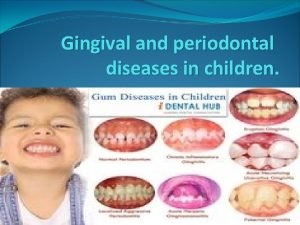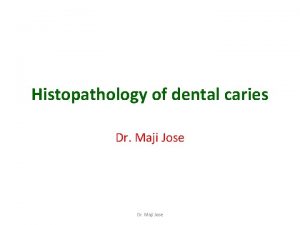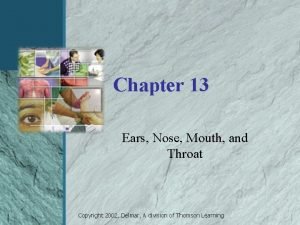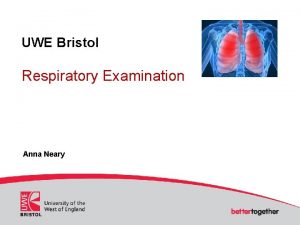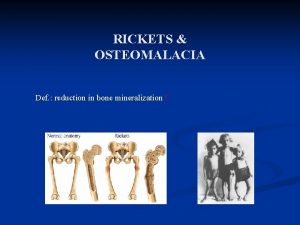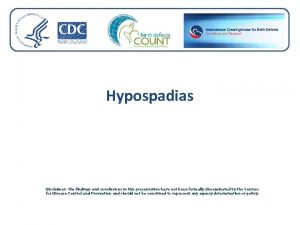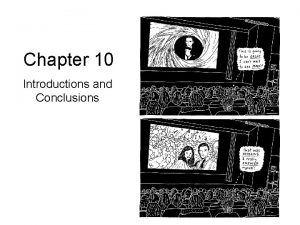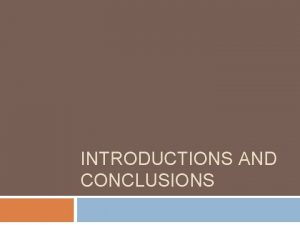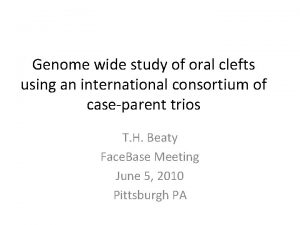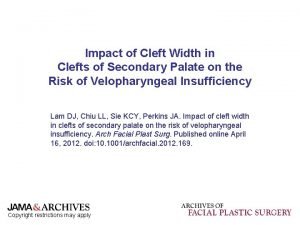Orofacial Clefts Disclaimer The findings and conclusions in

























- Slides: 25

Orofacial Clefts Disclaimer: The findings and conclusions in this presentation have not been formally disseminated by the Centers for Disease Control and Prevention and should not be construed to represent any agency determination or policy.

Learning Objectives • By the end of this presentation participants will be able to • Recognize the different types of orofacial clefts • Describe clinical features of orofacial clefts • Understand some epidemiological features of orofacial clefts • Apply tips for coding and reporting Orofacial Clefts | 2

Anatomy of the Lip Philtrum Cupid’s bow Nasal sill Vermillion Photo courtesy of Alina Flores Orofacial Clefts | 3

Anatomy of the Palate Primary palate Lip Alveolar ridge (Gum) Incisor foramen Hard palate Secondary palate Soft palate Uvula Orofacial Clefts | 4

Lip and Palate Formation Illustration source: Nat Rev Genet. 2011 March; 12(3): 167– 178 http: //www. ncbi. nlm. nih. gov/pmc/articles/PMC 3086810/ Orofacial Clefts Photos courtesy of CDC-Beijing Medical University collaborative project | 5

In Summary… • The primary palate is completely formed by the end of week 8 of gestation • The secondary palate is completely formed by the end of week 9 of gestation • Therefore, anything that happens after week 9 of gestation is unlikely to cause or prevent a cleft lip or a cleft palate Orofacial Clefts | 6

Common Orofacial Clefts This presentation will focus on cleft lip only, cleft lip and palate, and cleft palate only. Cleft Lip Only Cleft Lip With Cleft Palate Only Orofacial Clefts Partial or complete fissure of the upper lip. It can be unilateral or bilateral, and can be associated with a cleft of the gum. Cleft of the upper lip extending through the primary and secondary palates, with or without extension through the soft palate. Cleft lip and palate is the most common orofacial cleft. Fissure of the palate, which can affect the soft and hard palate, or only the soft palate. | 7

Selected Epidemiologic Features of Orofacial Clefts Feature Prevalence Variability of prevalence*** Associations **** Orofacial Clefts Typical Findings Affects an estimated 185, 000 births per year worldwide* Cleft lip only 3. 3 per 10, 000** Cleft lip and palate 6. 7 per 10, 000*** Cleft palate only 5. 0 per 10, 000*** Total orofacial clefts 15. 0 per 10, 000 Varies among populations and race/ethnic groups Cleft lip only or cleft lip and palate : Japan 21 per 10, 000; Norway 13. 26 per 10, 000; China 13. 49 per 10, 000 Cleft palate only : Malta 16 per 10, 000; Finland 14 per 10, 000 Orofacial clefts may be isolated or associated with other birth defects • 25 -30% of cleft lip and palate are associated with other defects (~half are due to syndromes); more common in bilateral cases • estimated 25 -50% cleft palate only are associated with other defects | 8

Prevalence of CL±P by Geographic Area (per 10, 000) Source: 2010_ Cleft Palate-Craniofacial Journal, January 2011 Vol 48 No 1. Prevalence at Birth of Cleft Lip With or Without Cleft Palate: Data From the International Perinatal Database of Typical Oral Clefts (IPDTOC). Orofacial Clefts | 9

Diagnosis Cleft lip only is usually easily recognized on physical examination after delivery Direct visualization of the pharynx after delivery is needed to detect a cleft palate When visualization is difficult, palpation of palate with a finger may be useful Prenatal diagnoses should not be included in surveillance data unless it is confirmed postnatally Prenatal Image of cleft lip only Photo courtesy of Alberto de la Vega MD, FACOG Orofacial Clefts Reproduced with permission from the Hong Kong Medical Journal (To WW. Prenatal diagnosis and assessment of facial clefts: where are we now? Hong Kong Med J 2012; 18: 14652), 2012, Hong Kong Academy of Medicine. Postnatal image of cleft lip only | 10

Cleft Palate: Heterogeneous Phenotype Bifid Uvula Cleft hard palate Cleft hard palate with cleft lip, specified as unilateral Cleft hard palate with bilateral cleft lip Photos courtesy of Dr. Peter Mossey Orofacial Clefts | 11

Main Clinical Features Feature Typical Findings Sex differences Cleft lip with or without cleft palate: 60 -80% are males Isolated clefts of secondary palate more frequent in females Site of clefts Cleft lip only: 21% Cleft lip with cleft palate: 46% Cleft of secondary palate only: 33% Laterality of cleft lip Unilateral clefts • More common in the left side (2: 1) • More common than bilateral (9: 1) • Associated with cleft palate in 68% of cases Bilateral cleft lip is associated with cleft palate in 86% of cases Types of cleft lip Microform (presence of vertical groove and vermilion notching) • not counted in surveillance of orofacial clefts Unilateral cleft lip (complete or incomplete) Bilateral cleft lip Types of cleft palate Cleft palate associated with cleft lip Cleft palate only • Cleft palate (hard or soft palate) • Submucous cleft palate Source: Harold Chen. Atlas of Genetic Diagnosis and Counseling. Humana Press 2006 Orofacial Clefts | 12

Robin Sequence • Robin sequence is characterized by small jaw in size (micrognathia) or set back from the upper jaw (retrognathia) • As a result, the tongue tends to be displaced back towards the throat, where it can fall back and obstruct the airway (glossoptosis) • Most infants, but not all, will also have a cleft palate, but none will have a cleft lip • Some cases may present a “U” shaped cleft of the palate Photo courtesy of Jones LK, Jones CM, del Campo M. Smith’s Recognizable Patterns of Human Malformations. Elsevier Saunders. 2013 Orofacial Clefts Photo courtesy of http: //en. atlaseclamc. org/ | 13

Atypical Facial Clefts • • Clefts involving lip, face and possibly palate Two main types (classification by Tessier) • • • Oro-auricular clefts occur with incomplete merging of maxillary and mandibular processes and are otherwise known as lateral clefts of the mouth. Oro-orbital clefts do not follow the normal lines of facial fusion and may be more bizarre, leading to disruption and distortion of normal anatomy, particularly of the eye and nose. Many are disruptions (amniotic band sequence or limb-body wall complex). Photos courtesy of Stevenson ER and Hall GJ. Human Malformations and Related Anomalies. 2 nd Ed. Oxford Univ Press. 2006. Orofacial Clefts | 14

Tips for Describing • A photograph should be taken, useful for review • Essential in atypical types • Use a drawing if photograph is not possible • Describe precisely: • • Laterality: right, left, bilateral • Lower lip: pits present or not • Extension of the lip’s cleft: minimum, partial or total • Involvement of the gum • Involvement of the nasal sill • Premaxilla status: present or absent • Extension of the palate’s cleft: hard and/or soft • Presence of significant micrognathia and glossoptosis • Shape of palate’s cleft: “U” shape or “V” shape Describe any additional malformations if present • In presence of a median cleft lip it is important to evaluate whether it is secondary to holoprosencephaly; do not include median clefts in surveillance of cleft lip and palate • Indicate whether a clinical geneticist was consulted Orofacial Clefts | 15

ICD-10 RCPCH Coding of Cleft Palate Q 35 Cleft palate (avoid using this general code if more specific information is available) Fissure of palate; Palatoschisis Q 35. 1 Cleft hard palate Q 35. 3 Cleft soft palate Q 35. 5 Cleft hard palate with cleft soft palate Q 35. 59 Complete cleft palate Cleft hard palate with cleft soft palate Q 35. 9 Cleft palate, unspecified Q 87. 0 Robin (sequence or defect; includes micrognathia, posterior displacement of the tongue, cleft palate)* Note: most specialists do not agree on the existence of cleft palaterality, as this defect is the result of a failure of the palatal shelves to fuse in the midline. For this reason, the preferred codes are: Q 35. 1 Cleft hard palate; Q 35. 3 Cleft soft palate; Q 35. 59 Cleft hard palate with cleft soft palate; Q 35. 9 Cleft palate and Q 87. 0 Robin (sequence or defect; includes micrognathia, posterior displacement of the tongue, cleft palate). Exclusions Q 35. 7 Q 35. 9 Q 38. 5 Cleft uvula Bifid uvula Submucous cleft Q 37–Q 37. 9 Cleft palate with cleft lip ** Absence of uvula * ICD-10 lists Robin sequence as an exclusion from the Q 35 series. However, because it is such a common condition, the 87. 0 code is suggested. Orofacial Clefts | 16

ICD-10 RCPCH Coding of Cleft Lip Q 36 Cleft lip (avoid using this general code if more specific information is available) Cheiloschisis; Congenital fissure of lip; Harelip; Labium leporinum Q 36. 0 Cleft lip, bilateral Q 36. 9 or Q 36. 90 Cleft lip unilateral Q 36. 99 Cleft lip, unspecified Exclusions Q 36. 1 Cleft lip, median Pseudocleft or microform cleft lip (no associated ICD-10 codes) Oblique facial clefts (Tessier type facial clefts) (no associated ICD-10 codes) Orofacial Clefts | 17

ICD-10 RCPCH Coding of Cleft Lip and Palate Q 37 Cleft palate with cleft lip (avoid using this general code if more specific information is available) Q 37. 0 Cleft hard palate with bilateral cleft lip Q 37. 10 Cleft hard palate with cleft lip, specified as unilateral Q 37. 19 Cleft hard palate with cleft lip, unspecified Q 37. 2 Cleft soft palate with bilateral cleft lip Q 37. 3 Cleft soft palate with unilateral cleft lip Q 37. 4 Cleft hard palate and soft palate with bilateral cleft lip Q 37. 5 Cleft hard palate and soft palate with unilateral cleft lip Q 37. 59 Cleft hard palate and soft palate with cleft lip, unspecified Q 37. 8 Unspecified cleft palate with bilateral cleft lip Q 37. 9 Unspecified cleft palate with unilateral cleft lip Q 37. 99 Cleft palate with cleft lip, unspecified Exclusions Oblique facial clefts (Tessier type facial clefts) Q 04. 2 Cases with known or probable holoprosencephaly Q 79. 80 Cases with known or probable amniotic band/constriction band presence * *ICBDSR recommends using Q 79. 80 to identify the presence of an amniotic band. The anomaly is coded as the code for the specific anomaly, as well as the Q 79. 80 amniotic band code. Orofacial Clefts | 18

Tips for coding Robin sequence • Robin sequence has its own code: Q 87. 08, this sequence may have or not a cleft palate, each individual code should be coded, if present: • Micrognathia: K 07. 00 • Glossoptosis: Q 38. 3 dislocation or displacement of tongue • Cleft palate Q 35 heading with the appropriate fourth digit Orofacial Clefts | 19

Amniotic Band Sequence • Birth defects caused by entrapment of fetal parts in fibrous amniotic bands while in utero • This should not be counted as cleft lip and palate Note: The ICBDSR uses Q 79. 80 to identify the presence of an amniotic band. The anomaly is coded as the code for the specific congenital anomaly, as well as the Q 79. 80 amniotic band code. Photo courtesy of CDC-Beijing Medical University collaborative project Orofacial Clefts | 20

Further information useful for reporting, extracting or coding: minor anomalies of mouth Minor Anomalies | 21

Labial pit/fistula Q 38. 00 • • • Definition : Depression located on the vermilion of the lower lip, usually paramedian Evaluation: Objective Lower lip pits are typically seen in the van der Woude syndrome, which also includes cleft lip and/or cleft palate Lip pits may be connected to minor salivary glands in the lower lip. Occasionally, a lip pit may have a surrounding tissue elevation Lip pits should be differentiated from pits located at the labial commissure (cheilion), known as commissural pits, which have no clinical relevance Lower lip pits Note: these are usually just lateral to the midline. Commissural pit Note: these are always located at the same position at the corners of the oral aperture Photso courtesy of Carey JC, Cohen MM Jr, Curry CJ, Devriendt K, Holmes LB, Verloes A. Elements of morphology: standard terminology for the lips, mouth, and oral region. Am J Med Genet A. 2009 Jan; 149 A(1): 77 -92. Mouth Minor Anomalies | 22

Absence of uvula Q 38. 5 • Definition: Lack of the uvula • Evaluation: Objective • Comment: Rare anomaly Photo courtesy of Carey JC, Cohen MM Jr, Curry CJ, Devriendt K, Holmes LB, Verloes A. Elements of morphology: standard terminology for the lips, mouth, and oral region. Am J Med Genet A. 2009 Jan; 149 A(1): 77 -92. Mouth Minor Anomalies | 23

Bifid uvula Q 35. 7 • • Definition: Uvula separated into two parts most easily seen at the tip Evaluation: Objective Comments: Although this relationship has not been fully confirmed, some have regarded bifid uvula as a marker for submucous cleft palate and have coded it under the heading Q 35, which identifies cleft palate. Bifid uvula is considered a minor anomaly and should be coded as Q 35. 7 Synonym: Double uvula Photo courtesy of Carey JC et al. Elements of morphology: standard terminology for the lips, mouth, and oral region. Am J Med Genet A. 2009 Jan; 149 A(1): 77 -92. Mouth Minor Anomalies Photo courtesy of http: //en. wikipedia. org/wiki/Wikipedia: Featured_pic ture_candidates/Bifid_uvula | 24

Questions? If you have questions please send an email to centre@icbdsr. org or to birthdefectscount@cdc. gov Orofacial Clefts | 25
 Retrocuspid papilla
Retrocuspid papilla Pharyngeal pouch and cleft
Pharyngeal pouch and cleft Mount and hume classification of dental caries
Mount and hume classification of dental caries Presenting insights and findings
Presenting insights and findings Law of continuity psychology attachment
Law of continuity psychology attachment Presentation of data what chapter
Presentation of data what chapter Mouth assessment normal findings
Mouth assessment normal findings Findings and discussion
Findings and discussion Conclusion for lamb to the slaughter
Conclusion for lamb to the slaughter Data analysis in research
Data analysis in research Chapter 4 findings and discussion
Chapter 4 findings and discussion Drawing conclusions and making inferences powerpoint
Drawing conclusions and making inferences powerpoint Make inferences and draw conclusions
Make inferences and draw conclusions Making conclusions from analyzed data
Making conclusions from analyzed data Inferences and conclusions practice
Inferences and conclusions practice How to make a generalization
How to make a generalization Making inferences and drawing conclusions
Making inferences and drawing conclusions What is logic
What is logic Make inferences and draw conclusions
Make inferences and draw conclusions Findings of qualitative research
Findings of qualitative research Tactile fremitus
Tactile fremitus Findings example in research
Findings example in research Communicating research findings in nursing
Communicating research findings in nursing Type of data collected in quantitative research
Type of data collected in quantitative research Costal angle
Costal angle Causes of rickets
Causes of rickets
